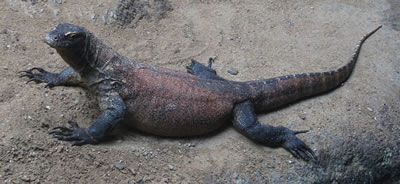
Image: Wikipedia.org (Creative Commons License)
Description: The prehistoric looking Komodo Dragon is the world's largest living lizard, reaching a maximum ength of ten feet, half of which is the tail, and a maximum weight of 350 pounds.Most, however, are much smaller and the average dragon is about 150 pounds. Dragons are entirely grayish with powerful arms and legs with huge, curved claws and a yellow, forked tongue used for smelling. The saliva of this massive reptile is full of bacteria because its gums are nearly always lacerated and sliced open when it feeds. Although it has a poor sense of hearing, the Komodo Dragon has excellent day vision and an incredible sense of smell that is thought to be able to detect the smell of carrion more than two miles away! It also has extra sensory scales around the ears, lips, chin, and soles of the feet.
Diet: The Komodo Dragon is a strict carnivore and feeds on deer, pigs, monkeys, birds, other medium-sized mammals, and carrion. Prey is usually swallowed whole, sometimes after it has been rammed against a tree to make it more compact. After a meal, the dragon regurgitates a huge pellet made of bones, fur, and other indigestible matter. Dragons have extremely slow metabolic rates and may only eat once or twice every month. Prey is ambushed and killed outright or is left to die over a period of days from the dragon's toxic saliva. After a biting a large animal, the dragon can follow its scent to find its place of death. Some research has suggested that dragons are smart enough to intentionally startle a pregnant deer into having a miscarriage whose remains are then devoured. Other evidence suggests that these reptiles have occasionally dug up human remains to feast on.
Habitat/Range: The Komodo Dragon prefers dry savannas, grasslands and tropical forests and is sometimes observed sleeping in burrows and spends much of its time inactive during the heat of the summer. It is endemic to several Indonesian islands.
Breeding: Komodo Dragons mate between April and August and eggs are layed in September. During mating time, males become extremely aggressive and stage "wrestling matches" for the rights to mate with females. Females lay their eggs in burrows or abandoned nesting mounds of the Orange-footed Scrubfowl. Clutches normally contain about 20 eggs, which hatch after seven or eight months.Young dragons often take to the trees to avoid being eaten by predators, including adult dragons. Young dragons further protect themselves when feeding by rolling in droppings to deter adults from feeding on them. Interestingly, studies have recently been done in zoos that have suggested female captive dragons may be able to lay fertilized eggs without the presence of a male. This phenomenon, known as Parthenogenesis, may be an adaptation of some sort to enable the species to reproduce when males are not available, especially because all of the documented offspring in these circumstances have been males.
Status: The Komodo Dragon is a threatened species because of its small population, narrow distribution, and the looming possibility of a natural disaster destroying the entire population. Poaching, habitat loss, and fires have also negatively impacted this species. Furthermore,this species does relatively poorlyin captivity and only a couple of zoos have been successful in breeding them. To conserve this unusual reptile, the nation of Indonesia established Komodo National Park in 1980.